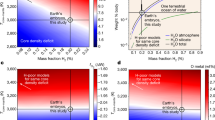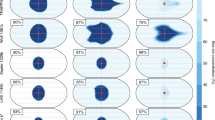Abstract
Understanding the origins of the diversity in terrestrial planets is a fundamental goal in Earth and planetary sciences. In the Solar System, Venus has a similar size and bulk composition to those of Earth, but it lacks water1,2,3. Because a richer variety of exoplanets is expected to be discovered, prediction of their atmospheres and surface environments requires a general framework for planetary evolution. Here we show that terrestrial planets can be divided into two distinct types on the basis of their evolutionary history during solidification from the initially hot molten state expected from the standard formation model4,5. Even if, apart from their orbits, they were identical just after formation, the solidified planets can have different characteristics. A type I planet, which is formed beyond a certain critical distance from the host star, solidifies within several million years. If the planet acquires water during formation, most of this water is retained and forms the earliest oceans. In contrast, on a type II planet, which is formed inside the critical distance, a magma ocean can be sustained for longer, even with a larger initial amount of water. Its duration could be as long as 100 million years if the planet is formed together with a mass of water comparable to the total inventory of the modern Earth. Hydrodynamic escape desiccates type II planets during the slow solidification process. Although Earth is categorized as type I, it is not clear which type Venus is because its orbital distance is close to the critical distance. However, because the dryness of the surface and mantle predicted for type II planets is consistent with the characteristics of Venus, it may be representative of type II planets. Also, future observations may have a chance to detect not only terrestrial exoplanets covered with water ocean but also those covered with magma ocean around a young star.
This is a preview of subscription content, access via your institution
Access options
Subscribe to this journal
Receive 51 print issues and online access
$199.00 per year
only $3.90 per issue
Buy this article
- Purchase on Springer Link
- Instant access to full article PDF
Prices may be subject to local taxes which are calculated during checkout




Similar content being viewed by others
References
Lewis, J. S. & Grinspoon, D. H. Vertical distribution of water in the atmosphere of Venus: a simple thermochemical explanation. Science 249, 1273–1275 (1990)
Nimmo, F. & McKenzie, D. Volcanism and tectonics on Venus. Annu. Rev. Earth Planet. Sci. 26, 23–51 (1998)
Kiefer, W. S., Richards, M. A., Hager, B. H. & Bills, B. G. A dynamic model of Venus’s gravity field. Geophys. Res. Lett. 13, 14–17 (1986)
Chambers, J. E. & Wetherill, G. W. Making the terrestrial planets: N-body integrations of planetary embryos in three dimensions. Icarus 136, 304–327 (1998)
Canup, R. M. Dynamics of lunar formation. Annu. Rev. Astron. Astrophys. 42, 441–475 (2004)
Elkins-Tanton, L. T. Linked magma ocean solidification and atmospheric growth for Earth and Mars. Earth Planet. Sci. Lett. 271, 181–191 (2008)
Matsui, T. & Abe, Y. Evolution of an impact-induced atmosphere and magma ocean on the accreting Earth. Nature 319, 303–305 (1986)
Zahnle, K. J., Kasting, J. F. & Pollack, J. B. Evolution of a steam atmosphere during Earth’s accretion. Icarus 74, 62–97 (1988)
Abe, Y. & Matsui, T. Evolution of an impact-generated H2O–CO2 atmosphere and formation of a hot proto-ocean on Earth. J. Atmos. Sci. 45, 3081–3101 (1988)
Kasting, J. F. Runaway and moist greenhouse atmospheres and the evolution of Earth and Venus. Icarus 74, 472–494 (1988)
Nakajima, S., Hayashi, Y. & Abe, Y. A study on the ‘runaway greenhouse effect’ with a one-dimensional radiative–convective equilibrium model. J. Atmos. Sci. 49, 2256–2266 (1992)
Watson, A. J., Donahue, T. M. & Walker, J. C. G. The dynamics of a rapidly escaping atmosphere: applications to the evolution of Earth and Venus. Icarus 48, 150–166 (1981)
Hirschmann, M. M. Water, melting, and the deep Earth H2O cycle. Annu. Rev. Earth Planet. Sci. 34, 629–653 (2006)
Caro, G. Early silicate Earth differentiation. Annu. Rev. Earth Planet. Sci. 39, 31–58 (2011)
Cavosie, A. J., Valley, J. W., Wilde, S. A. & Edinburgh Ion Microprobe Facility Magmatic δ18O in 4400–3900 Ma detrital zircons: a record of the alteration and recycling of crust in the Early Archean. Earth Planet. Sci. Lett. 235, 663–681 (2005)
Canil, D. & O’Neill, H. St C. Distribution of ferric iron in some upper-mantle assemblages. J. Petrol. 37, 609–635 (1996)
Trail, D., Watson, E. B. & Tailby, N. D. The oxidation state of Hadean magmas and implications for early Earth’s atmosphere. Nature 480, 79–82 (2011)
Lewis, J. S. Venus: atmospheric and lithospheric composition. Earth Planet. Sci. Lett. 10, 73–80 (1970)
Kasting, J. F. & Pollack, J. B. Loss of water from Venus. I. Hydrodynamic escape of hydrogen. Icarus 53, 479–508 (1983)
Mackwell, S. J., Zimmerman, M. E. & Kohlstedt, D. L. High-temperature deformation of dry diabase with applications to tectonics on Venus. J. Geophys. Res. 103, 975–984 (1998)
Moresi, L. & Solomatov, V. Mantle convection with a brittle lithosphere: thoughts on the global tectonic styles of the Earth and Venus. Geophys. J. Int. 133, 669–682 (1998)
Nimmo, F. Why does Venus lack a magnetic field? Geology 30, 987–990 (2002)
Chassefière, E. Hydrodynamic escape of oxygen from primitive atmospheres: applications to the cases of Venus and Mars. Icarus 124, 537–552 (1996)
The Extrasolar Planets Encyclopedia. <http://exoplanet.eu/> (2012)
Batalha, N. M. et al. Planetary candidates observed by Kepler. III. Analysis of the first 16 months of data. Astrophys. J. Suppl. S.. 204, 24, http://dx.doi.org/10.1088/0067-0049/204/2/24 (2013)
Schaefer, L., Lodders, K. & Fegley B Vaporization of the Earth: application to exoplanet atmospheres. Astrophys. J.. 755, 41, http://dx.doi.org/10.1088/0004-637X/755/1/41 (2012)
Papale, P. Modeling of the solubility of a one-component H2O or CO2 fluid in silicate liquids. Contrib. Mineral. Petrol. 126, 237–251 (1997)
Ribas, I., Guinan, E. F., Güdel, M. & Audard, M. Evolution of the solar activity over time and effects on planetary atmospheres. I. High-energy irradiances (1–1700 Å). Astrophys. J. 622, 680–694 (2005)
Abe, Y. Thermal and chemical evolution of the terrestrial magma ocean. Phys. Earth Planet. Inter. 100, 27–39 (1997)
Gough, D. O. Solar interior structure and luminosity variations. Sol. Phys. 74, 21–34 (1981)
Presnall, D. C. & Hoover, J. D. in Magmatic Processes: Physicochemical Principles (ed. Mysen, B. O. ) vol. 1, 75–89 (Geochemical Society Special Publication, 1984)
Johnson, K. T. M. & Dick, H. J. B. Open system melting and temporal and spatial variation of peridotite and basalt at the Atlantis II fracture zone. J. Geophys. Res. 97, 9219–9241 (1992)
Solomatov, V. in Evolution of the Earth (ed. Stevenson, D. ) 91–119 (Treatise on Geophysics 9, Elsevier, 2007)
Kopparapu, R. K. et al. Habitable zones around main-sequence stars: new estimates. Astrophys. J.. 765, 131, http://dx.doi.org/10.1088/0004-637X/765/2/131 (2013)
Acknowledgements
We thank J.F. Kasting for constructive comments on the manuscript. We appreciate proofreading and editing assistance from the GCOE programme. This work was supported by Grants-in-Aid for Scientific Research (KAKENHI) from the Ministry of Education, Culture, Sports, Science and Technology (23103003) and from Japan Society for the Promotion of Science (23340168 and 22740291). This study is a part of the PhD thesis of K.H. submitted to the University of Tokyo.
Author information
Authors and Affiliations
Contributions
K.H. and Y.A. conceived the initial idea. K.H. constructed the coupled model and performed the calculations. Y.A. contributed to the modelling as well. H.G. provided suggestions on exoplanetary science. All authors discussed the results and implications and commented on the manuscript.
Corresponding author
Ethics declarations
Competing interests
The authors declare no competing financial interests.
Supplementary information
Supplementary Information
This file contains Supplementary Discussions 1-5, Supplementary Figures 1-3 and additional references. (PDF 898 kb)
Rights and permissions
About this article
Cite this article
Hamano, K., Abe, Y. & Genda, H. Emergence of two types of terrestrial planet on solidification of magma ocean. Nature 497, 607–610 (2013). https://doi.org/10.1038/nature12163
Received:
Accepted:
Published:
Issue Date:
DOI: https://doi.org/10.1038/nature12163
This article is cited by
-
Long-lived volcanic resurfacing of Venus driven by early collisions
Nature Astronomy (2023)
-
A cool runaway greenhouse without surface magma ocean
Nature (2023)
-
Revealing the atmospheres of highly irradiated exoplanets: from ultra-hot Jupiters to rocky worlds
Astrophysics and Space Science (2023)
-
Venus, the Planet: Introduction to the Evolution of Earth’s Sister Planet
Space Science Reviews (2023)
-
Synergies Between Venus & Exoplanetary Observations
Space Science Reviews (2023)
Comments
By submitting a comment you agree to abide by our Terms and Community Guidelines. If you find something abusive or that does not comply with our terms or guidelines please flag it as inappropriate.



